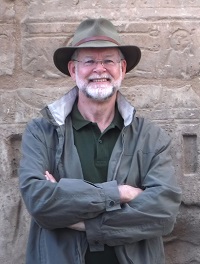The Epigraphic Survey, ARCE, and Khonsu Temple: Collaboration and Ancient Secrets Revealed
July 24, 2021 1PM ET/ 7PM EET
(Registration form below)
Speaker: Dr. W. Raymond Johnson
Lecture Information:
ARCE began its floor restoration program at Khonsu Temple as follow up to the USAID dewatering initiative for Karnak Temple and Luxor Temple that was activated in 2006 with additional funding from USAID. Before 2006, the underpinnings of the temple were so saturated with ground water, restoration and conservation were not feasible. ARCE began its conservation and floor restoration program there in 2008, and drawings and plans from the Oriental Institute publications were copied and used to plot conservation condition assessment and subsequent treatment by the ARCE conservation team.
Khonsu Temple was constructed by Ramesses III toward the end of his reign, and rather than quarry fresh stone for the structure, he dismantled at least three mortuary temples on the west bank for building material: the mortuary temples of Amenhotep III, Ay/Horemheb, and Amenhotep Son of Hapu.
When inscribed, reused blocks were exposed in ARCE’s floor restoration work, Dr. Johnson’s team recorded the inscribed reused blocks exposed during the process, and for several years, sub-contracted with ARCE. The team is now documenting the reused blocks on the roof area and in the pylon and plan to resume that work this season.
The restoration work resulted in some astonishingly significant material being exposed for a short while, just enough time for Dr. Johnson and his team to record it before it was covered over with restoration stone, and marks a major chapter in the documentation program at the temple.
About W. Raymond Johnson:
Chicago House Director W. Raymond Johnson attended college at Tulane University in New Orleans, and received his doctorate in Egyptian Archaeology from the University of Chicago in 1992 with his dissertation entitled, An Asiatic Battle Scene of Tutankhamun from Thebes: A Late Amarna Antecedent of the Ramesside Battle Narrative Tradition. He has participated in excavations at the site of Fort William Henry in Colonial Pemaquid, Maine; at Chogha Mish, Iran; at Quseir Al-Qadim on the Red Sea coast of Egypt; and at Carthage, Tunisia.
Ray joined the Epigraphic Survey, Oriental Institute, University of Chicago based at Chicago House in Luxor, Egypt, full time in 1979 as epigraphic draftsman, where he helped document the Opet reliefs of Tutankhamun in the great Colonnade Hall of Luxor Temple and began the Luxor Temple fragment project. He served as Senior Artist from 1982, became Assistant Director in 1995, and was appointed Epigraphic Survey Director in 1997. He is a Research Associate Professor of the University of Chicago’s Department of Near Eastern Languages and Civilizations (NELC) and the Oriental Institute; is project director of the Memphis Amenhotep III Reused Block Project; and currently directs the Amarna Talatat Project where he is reconstructing wall scenes from the stone monuments of Akhenaten and Nefertiti’s cult city to the Aten.
Registration will close 24 hours before the lecture starts. Registration does not include any future lectures in this series.


